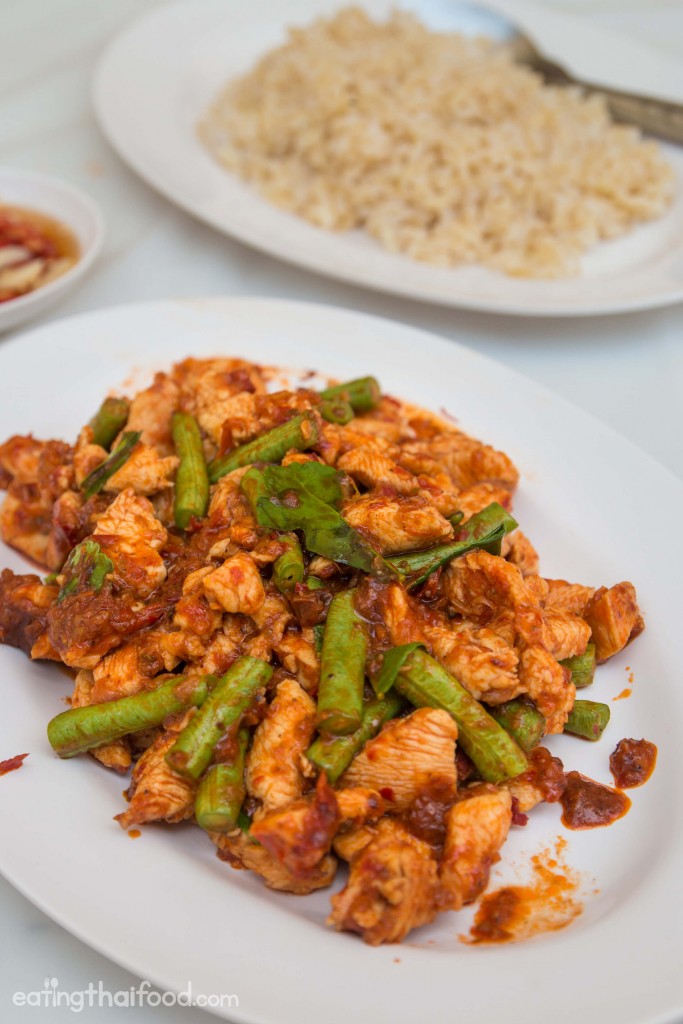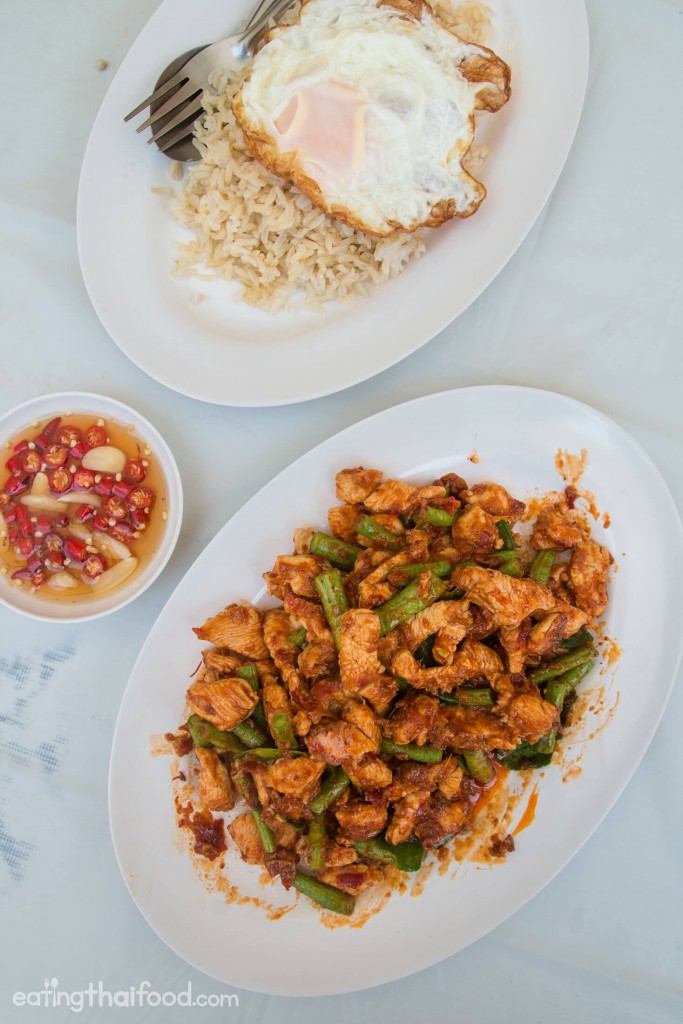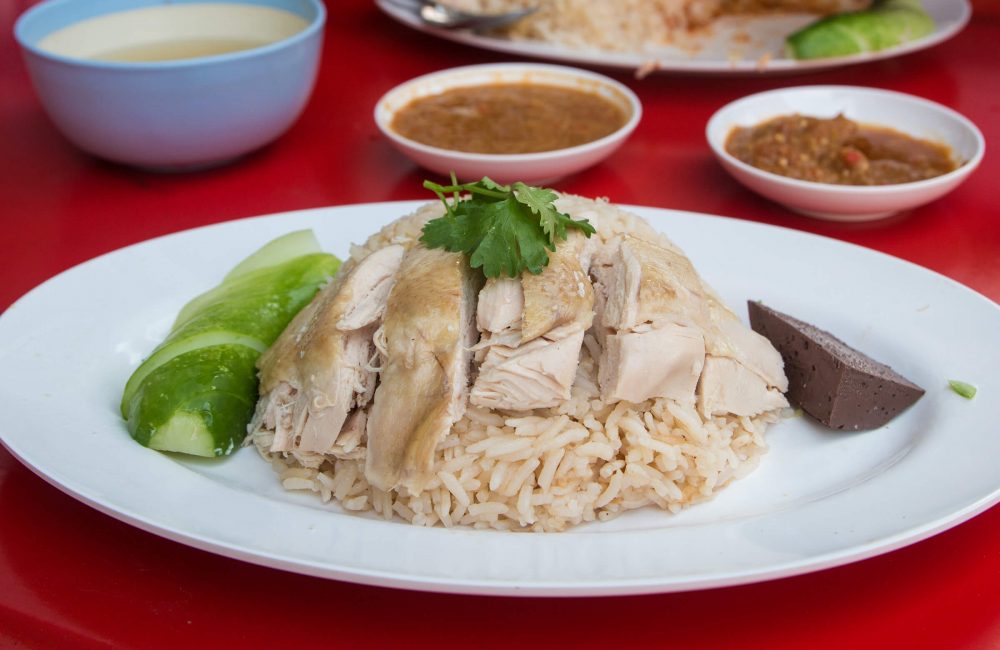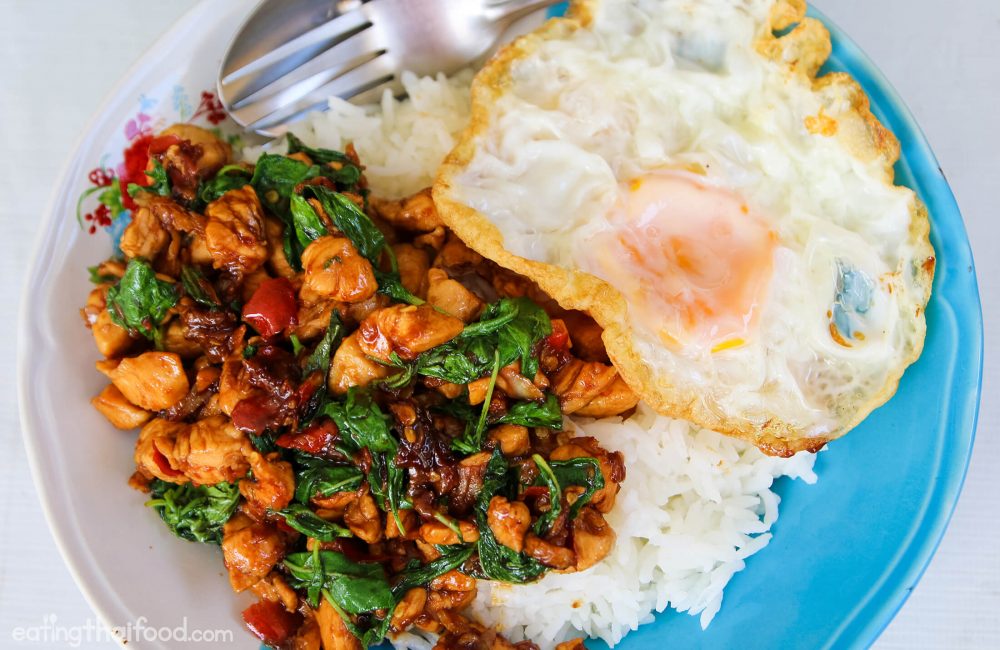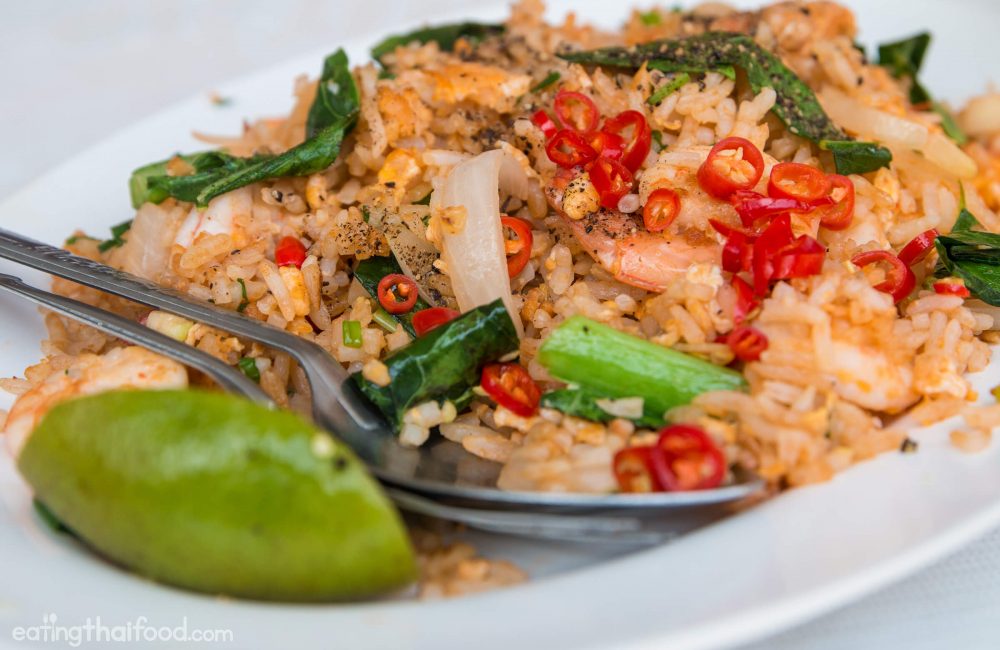Gai Pad Prik Gaeng Recipe (วิธีทำ ไก่ผัดพริกแกง)
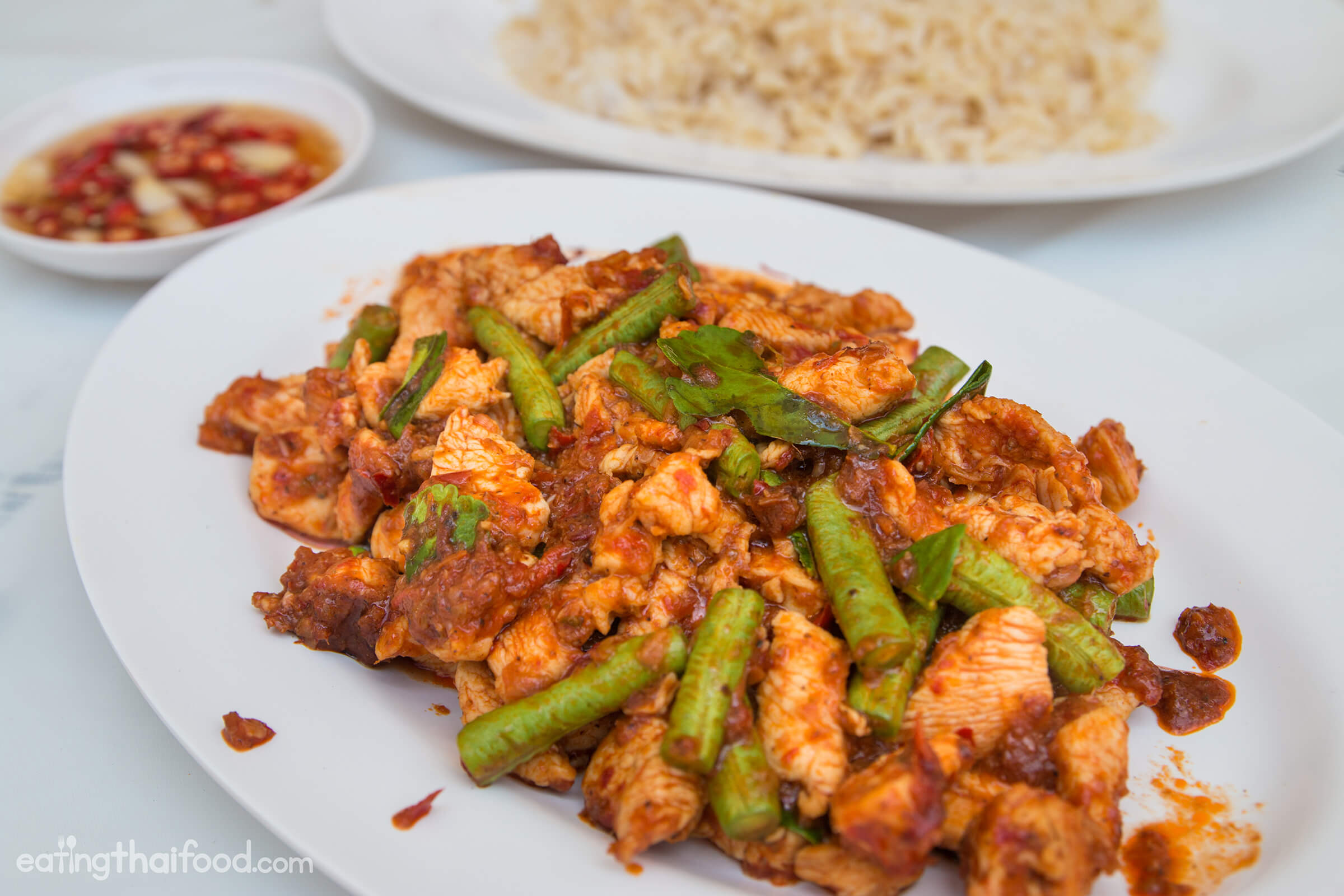
If you love the flavor of the curry, but the stir fry cooking method, you’ll love this Thai recipe.
Along with chicken stir fried with holy basil, chicken stir fried in red curry paste, known as gai pad prik gaeng (ไก่ผัดพริกแกง) in Thai, is one of my favorite quick and easy Thai street food dishes.
The best thing about this dish is that it’s available at nearly every single Thai stir fry street food restaurant, and while it’s excellent on the streets, it’s even better when you make it at home using freshly made red curry paste.

Thai red curry paste
This gai pad prik gaeng recipe (ไก่ผัดพริกแกง) is really easy to make, as long as you already have some Thai red curry paste (เครื่องแกงเผ็ด) available.
The Thai red curry paste forms the base of flavor for this gai pad prik gaeng (chicken fried with red curry paste ไก่ผัดพริกแกง).
Ingredients you’ll need:
- 300 grams, I used about 1.5 chicken breasts for this recipe
- 3 strands of Chinese long beans (or about ⅓ cup of chopped string beans)
- 3 – 5 kaffir lime leaves
- 3 tablespoons Thai red curry paste
- 1 teaspoon fish sauce (here’s the fish sauce I usually use)
- ½ teaspoon sugar (depending on your preference)
- 1 tablespoon oil for stir frying
Note: If you want to get straight to the directions of this recipe, you can scroll below to the recipe box, otherwise keep reading for a more thorough explanation of how to cook this Thai chicken stir fried curry recipe.
Note #2: Making your own red curry paste is the best option, but if you’re not able to, you can try using red curry paste in a jar, my recommendation is for Mae Ploy red curry paste, but you’ll have to alter the salt and other seasonings in the recipe depending on the flavor of the packaged curry paste.
Once you have your Thai red curry paste ready to go, either freshly made, or from a can or bottle (but fresh is of course going to taste better), you’ve just got to fry it up with some chicken and a few other ingredients, and you’re ready to go.

Chicken fried with red curry paste
I used about 300 grams of chicken breast, which was 1.5 chicken breasts altogether.
First slice the chicken into small bite sizes pieces – I like to slice it pretty small because more flavor gets coated on each piece of chicken, plus it’s faster to fry.

Kaffir lime leaves
Along with Thai red curry paste and chicken (ไก่), for this recipe I used Chinese long beans (ถั่วฝักยาว, but I think green beans will also work fine), and kaffir lime leaves.
I used about 3 strands of long beans, cut into 1 inch pieces, and it equaled out to about 1/3 of a cup of them. So if you use green beans, chop up enough for about 1/3 of a cup.

Fish sauce used in this recipe
Since most of the amazing flavors are already taken care of the in red curry paste, you barely need any other seasoning.
Other than the paste, you’ll just need about 1 teaspoon of fish sauce (น้ำปลา taste it though, it depends on how salty your red curry paste is from the start), and normal Thais would add about 1 teaspoon of sugar, but when I make this recipe for myself I add just a pinch, if any, and that’s all.

Stir frying gai pad prik gaeng
Stir fry
Stir frying food is one of my favorite things to do in the world, it’s such a fast way to cook, and all the flavors remain in the pan and with the ingredients you fry.
For this gai pad prik gaeng recipe (ไก่ผัดพริกแกง), once all your ingredients are ready to go, turn on your stove to low heat.
Add about 1 tablespoon of oil (น้ำมัน) to your wok or pan, keeping it on low heat, and you can add in about 3 tablespoons of Thai red curry paste before the oil heats up too much.
If your pan is too hot the curry paste will burn, so keep it on low heat and just stir fry for about 30 seconds.
After your red curry paste is hot sizzling and fragrant, toss in your chicken, and season with a bit of fish sauce (red curry pastes can taste different and be of different saltiness, so make sure you taste test and see how it is before adding fish sauce), and a pinch of sugar, and fry until the chicken is all the way cooked.
Finally, at the end, toss in your long beans and kaffir lime leaves, stir fry for about 30 more seconds and your marvelous gai pad prik gaeng (ไก่ผัดพริกแกง) is ready.
- Gai pad prik gaeng (ไก่ผัดพริกแกง)
- Thai chicken fried with red curry paste
You can either serve gai pad prik gaeng (ไก่ผัดพริกแกง) directly over a plate of rice, or you can put it all onto a communal plate accompanied by a separate plate of rice.
Either way tastes just as good.

Serve it with a fried egg on the side
In Thailand when you order a dish like gai pad prik gaeng (ไก่ผัดพริกแกง), or any other stir fry dish, you have the choice to get a fried egg on the side.
This is not a requirement, but a fried egg on top of your rice along with the red curry paste chicken sure tastes incredible.
Before we get started making this recipe, be sure to watch the video below for all the cooking instructions and details.
(If you can’t see the video, watch it here: http://youtu.be/8QTOuWKOeVM)
Gai pad prik gaeng recipe (วิธีทำ ไก่ผัดพริกแกง)
(Thai recipe for chicken stir fried with red curry paste)
Time: about 15 – 20 minutes (if you have the red curry paste already prepared)
Recipe size: 1 plate of stir fried chicken, 1 – 2 people
Cooking utensils: wok, stir fry
Flavors: salty and spicy
Eat it with: fresh steamed rice and a fried egg on the side if you’d like
Be sure to check out our other Thai recipes here.

- 300 grams , or about 1.5 chicken breasts
- 3 strands of Chinese long beans (or about ⅓ cup of chopped string beans)
- 3 - 5 kaffir lime leaves
- 3 tablespoons Thai red curry paste (recipe here), or alternatively packaged red curry paste, but it won't be as good.
- 1 teaspoon fish sauce
- ½ teaspoon sugar
- 1 tablespoon oil for frying
- The first thing you need to do is take your chicken and slice it into small bite sized pieces. I like to cut it quite fine so there’s more surface area for flavor, and so it cooks quicker.
- Cut the Chinese long beans (or green beans) into 1 inch pieces.
- Once your chicken and long beans are cut, go ahead and light your stove on low heat and add in 1 tablespoon of oil. You really need to use about 1 tablespoon of oil, if you use less, the curry paste will burn and stick to the pan.
- No need to wait until your oil is hot, just toss in about 3 tablespoons of red curry paste into the oil and start stir frying it in the oil. Let it sizzle for about 20 - 30 seconds on low heat, and it should really be fragrant (you might even cough from the frying chilies!).
- Next add your chicken, turn up the heat to high, and start stir frying constantly, fully mixing the chicken with the curry sauce.
- Quickly season with 1 teaspoon of fish sauce (give your curry paste a test to see how salty it already is, from the package it might be saltier than the homemade version), and ½ teaspoon sugar.
- Stir fry constantly, and at this point if it’s getting dry, add a couple tablespoons of water.
- Keep stir frying the chicken on high heat for about 2 minutes until the chicken is fully cooked.
- When the chicken is fully cooked, add the sliced long beans, and then break in about 3 - 5 kaffir limes leaves.
- Stir fry for just 30 seconds and then turn off the heat. You want the long beans to still be nice and crisp.
- Dish your gai pad prik gaeng (ไก่ผัดพริกแกง) out onto a plate and serve with freshly steamed rice.

Always a tasty dish
To make your dish extra authentic, you can make a small bowl of prik nam pla, or fish sauce and chilies. Just dice up a few Thai chilies, and a clove of garlic, and add a couple tablespoons of fish sauce, and if you like, a squeeze of lime juice.
With each bite, you can scoop on a few pieces of chili and a drizzle of fish sauce – tastes especially wonderful on the egg.
Gai pad prik gaeng (ไก่ผัดพริกแกง) has such a wonderful fresh and pungent flavor. You’ll taste the dry chilies, garlic, shallots, and the lime zest from the kaffir limes leaves, and the kaffir lime peel in the paste.
It’s an extremely flavorful Thai dish.

One more close up of that amazing flavor!
Conclusion
Gai pad prik gaeng (ไก่ผัดพริกแกง) is a Thai dish that includes chicken stir fried in curry paste with long beans and kaffir lime leaves.
It’s one of my personal go-to Thai dishes in Bangkok, and so I’m excited to share with you this quick and simple recipe that tastes so incredibly delicious.
Eating gai pad prik gaeng (ไก่ผัดพริกแกง) is like having all the curry flavor coated onto pieces of chicken, and it’s absolutely delicious!
Want to cook more authentic Thai food? More recipes here.

